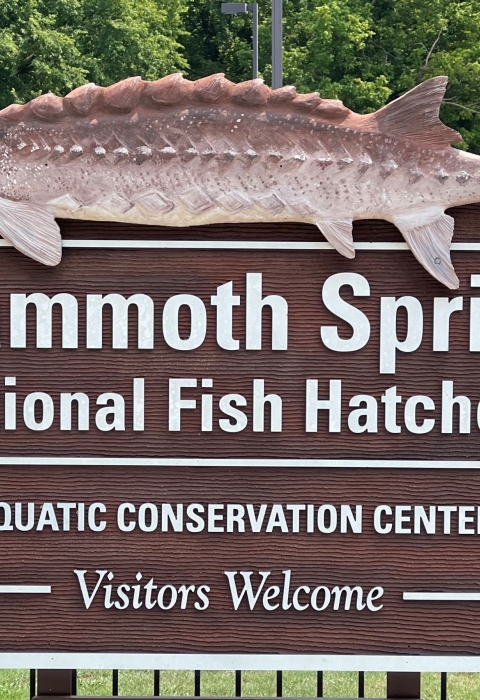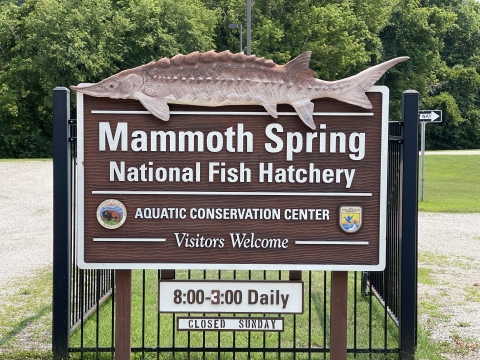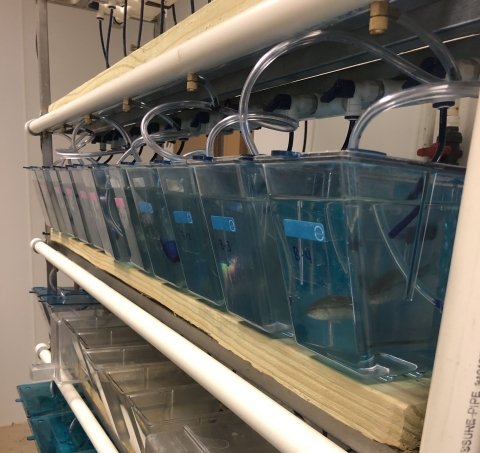About Us
Established in 1903, the Mammoth Spring National Fish Hatchery (NFH), located in Mammoth Spring, Arkansas, just South of the Missouri border about 65 miles northwest of Jonesboro, Arkansas. The hatchery is one of the oldest in the United States and was built in the Ozark foothills in northeast Arkansas due to the availability of the cool flowing water from the world’s tenth largest spring and its easy access to the railroad. Current programs include the recovery of endangered and threatened species such as freshwater mussels; restoration of Gulf Coast Striped Bass populations; and rainbow trout in the White River drainage. Since Mammoth Spring NFH has such an array of possible water habitats we are constantly adapting species that are being raised due to public, conservation and restoration needs and requests from our partners.
Our Mission
Since 1871, National Fish Hatcheries have been applying science-based approaches to conservation challenges. We work with our partners and engage the public to conserve, restore, and enhance fish and other aquatic resources for the continuing benefit of the American people. Conservation is at the heart of what we do, and we recognize that we do this work for the American people–both the present generation who benefit today and future generations who will inherit our legacy of conserving America’s aquatic resources.
This is a National Fish Hatchery which is supported by your Federal tax dollars. Fish raised on Federal hatcheries are stocked in public waters to support Federal fishery responsibilities mandated by law. These include fish for restoration where, for example, man-made dams have altered a stream’s natural reproductive capability; or to restore threatened or endangered populations of fish and other aquatic species. Fish are also used to support recreational fishing programs in federal and state waters. We also hold public events, such as fishing derby’s and educational outreach programs with a goal to educate the public of environmental and recreational issues and what the public can do to help rectify these issues.
Our History
Napoleon Hill stepped out to get some fresh air from a train heading to Kansas City Missouri. His feet landed on the walk of a newly constructed railroad depot in what would be Mammoth Spring AR. Little did this small community know how much this brief visit would change its future. Napoleon Hill, a wealthy investor from Memphis Tennessee, did not just admire the Spring that churns out of the ground, but was drawn to the overall potential of the area that surrounded this spring. His admiration and belief in the town was so strong that he invested heavily in it. One of his biggest investments was creating Spring Lake and the dam that holds its water, thus paving the way for the Mammoth Spring National Fish Hatchery.
Before Mammoth Spring National Fish Hatchery was established this site was a private hatchery owned by Napoleon Hill. It has been rumored the private ten acre hatchery and the water rights were donated to the Fish and Wildlife Service, under the condition that if it were ever to be closed as a federal hatchery it was to be returned to the Hill family along with the water rights.
In 1903 Mammoth Spring National Fish Hatchery was opened, which consisted of a few buildings and a farm pond program. During the 1970’s, the hatchery ended the farm pond program and directed their culturing efforts to increasing the native and recreational fish population. These cultured fish were loaded onto a specialized railroad boxcar and distributed into waters along the railway line. The railroad is conveniently located next to the hatchery, which was part of the original desire in creating the hatchery in its current location.
To this day, the hatchery continues to produce fish/aquatic species for recreational use and has created programs to rear to restore threatened or endangered populations of fish and other aquatic specie.
Other Facilities in this Complex
LEED Leadership, Energy, Environmental, Design
LEED was developed by U.S. Green Building Council (USGBC). LEED provides building owners and operators framework for construction, operation, and maintenance solutions for a green building design. LEED strives for improvements for the environmental and human health. They concentrate on five key categories. The five key categories are sustainable sites, water efficiency, energy and atmosphere, materials and resources, and indoor environmental quality.
Recycled Material Used in The Aquatic Conservation Center
- Steel frames, studs, roof, and wall panels made from 100% recycled steel.
- Carpet made from 45% recycled fiber (used plastic).
- Metal doors made from 59% recycled metal.
- Window frames made from 70% recycled material.
- Glazing (window glass) made from 100% recycled glass.
- Interior wood trim 100% reclaimed from old barn.
- Wood for interior benches 100% from old barn.
- Exterior concrete benches 100% from old barn.
- Ceiling tiles are made of 85% recycled material.
- Ceiling Grid is made from 100%recycled material.
Hatchery Water Cycle
Naturally Cooled spring water from Mammoth Spring is used for hatchery production and to conserve energy in the Aquatic Conservation Visitor Center.
- Rain Falls in the Ozark Mountains.
- Rain is filtered and cooled to 58 degrees as it percolates deep into the earth, where it becomes supersaturated with nitrogen and other gasses.
- Many subterranean streams eventually converge and well up in the spring, some of which is diverted to the hatchery.
- Spring water flows through a series of degassers to reduce the high levels of nitrogen that may be harmful to fish before being used for production. Some of this water is sent to the Visitor Center.
- At the Visitor Center, the water passes through a heat exchanger that uses the 58-degree water to heat and cool the Visitor Center.
- After the water is used in the heat exchange it is reused for other purposes.
a) Water is returned to the Spring River
b) Small amounts of water are used to irrigate plants around the Visitor Center.
c) Spring water is diverted to production ponds and used to raise fish
8. Water is evaporated from ponds and the river to clouds and rain starts the process again.





